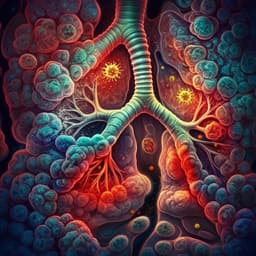
Medicine and Health
Multiscale statistical physics of the pan-viral interactome unravels the systemic nature of SARS-CoV-2 infections
A. Ghavasieh, S. Bontorin, et al.
This groundbreaking study by Arsham Ghavasieh, Sebastiano Bontorin, Oriol Artime, Nina Verstraete, and Manlio De Domenico delves into the systemic nature of SARS-CoV-2 infections. By comparing its protein interaction network with 92 other viruses, they uncover surprising similarities that highlight COVID-19's complex effects on multiple organs and body subsystems.
~3 min • Beginner • English
Introduction
The study addresses how SARS-CoV-2 compares to a broad panel of other viruses in terms of their impact on the human protein-protein interaction (PPI) network. Motivated by the need to understand similarities and differences between COVID-19 and other viral infections for insight into mechanisms and therapies, the authors use statistical physics and computational biology to characterize pan-viral patterns. They frame the human PPI targeted by viral proteins as an interdependent system and investigate how viral interactions perturb the network across micro, meso, and macro scales. The research question is which viruses are most similar to SARS-CoV-2 in their systemic impact on human cellular organization and information dynamics, and whether these similarities suggest that COVID-19 behaves as a systemic disease affecting multiple organs and subsystems.
Literature Review
The work builds on network medicine, where complex network analysis links genes, proteins, diseases, and drugs. PPI networks are key for understanding cellular processes and have been used to predict protein function, signal transduction, and drug target identification. Interactomes exhibit modular and hierarchical organization with cross-module interactions facilitating information exchange. Previous SARS-CoV-2 studies used virus-human PPIs to infer virus structure/function and to identify drug repurposing candidates. Recent findings highlighted sex- and age-related differences in COVID-19 outcomes and suggested pan-viral mechanisms among coronaviruses. However, comprehensive comparisons of SARS-CoV-2 to a wide array of viruses remain limited. This study addresses that gap by comparing 93 viruses using multi-scale physical and biological analyses.
Methodology
Data: Human interactome constructed by integrating STRING v10.5 and BIOGRID v3.5 into a standardized BIOSTR PPI with 19,945 proteins and 737,668 edges; analyses focused on the largest connected component (≈19,929 proteins). Virus-human interactions for 93 viruses were collected from viruses.string-db.org with confidence score ≥ 0.7. For SARS-CoV-2, due to the lack of STRING data at the time, 332 human targets from Gordon et al. (Nature 2020) were used. Virus-virus interactions were not considered.
Mapping biology to models: Two operational hypotheses were used regardless of DNA/RNA type. Type-I: viral interaction inhibits target protein function, modeled as target removal from the network. Type-II: viral interaction perturbs target function with systemic propagation according to biomolecular dynamics (perturbation propagation). More complex rewiring models were not pursued to avoid method-dependent biases.
Microscale analyses: (i) Percolation analysis of structural robustness under targeted removals; (ii) Dynamical perturbation analysis measuring system response via correlation functions to steady-state perturbations, quantifying distributed perturbation from targeted proteins.
Mesoscale analysis: Assess changes in modular and hierarchical organization after isolating targeted proteins. Community detection by multiscale modularity maximization (Louvain) and by hierarchical degree-corrected stochastic block model (DCSBM). Quantified changes in number of modules, modularity (ΔModules, ΔModularity), and hierarchy depth (number of levels) by comparing targeted vs untargeted networks. Partition similarity also assessed via normalized mutual information and Variation of Information.
Macroscopic spectral analysis: Defined a Gibbsian-like density matrix from the combinatorial Laplacian L = D − A: ρ(β,G) = e^{−βL}/Tr(e^{−βL}). Computed Massieu function φ(β,G) = log Tr(e^{−βL}) and von Neumann entropy S(β,G) = −Tr[ρ log ρ]. Modeled each virus-host interactome G′ as a perturbation of G and measured δS(β,G′) = S(β,G′) − S(β,G) and δφ(β,G′) = φ(β,G′) − φ(β,G) over temporal scales β ≈ 1, 3, 5.
Clustering approaches: For macroscopic features, used k-means clustering in the 2D feature space (δS, δφ) with number of clusters chosen by elbow method at each β. For integrated analyses, used UMAP for dimensionality reduction and HDBSCAN for density-based clustering, combining features from micro-, meso-, and macroscale analyses.
Biological enrichment and proximity analyses: Defined first-order (direct) and second-order (one-step neighbors) human interactors for each virus. Performed Reactome pathway and Gene Ontology Biological Process enrichment using clusterProfiler (enrichPathway and enrichGO with BP, p < 0.005). Binarized enrichment outputs and clustered viruses using binary distance and complete linkage. Also clustered by shared human protein targets for first- and second-order interactors. Tools: R (clusterProfiler, pheatmap). Parameters noted above.
Key Findings
- Microscale: Percolation analyses did not differentiate viruses due to high similarity of interactomes; dynamic perturbation analyses provided insights on perturbation distributed by individual targets but were insufficient alone to discriminate viruses.
- Mesoscale: Isolation of targeted proteins generally increased the number of modules and decreased modularity (Louvain), reducing hierarchy depth; DCSBM showed heterogeneous patterns with modularity often increasing post-targeting. SARS-CoV-2 exhibited a notable positive change in modularity (Louvain), similar to HPV16, Influenza A, and Bunyavirus. Human coronaviruses (SARS-CoV, Coronavirus-229E) showed comparable large variations in modular structure despite fewer targets.
- Macroscale spectral: Clustering in δS–δφ space across β revealed scale-dependent similarities. SARS-CoV-2 clustered with Human Respiratory Syncytial virus at small scales and with Measles at larger scales; it was near clusters containing SARS-CoV, Human Herpesvirus, and HIV-1, indicating proximity to viruses with systemic effects.
- Biological shared targets: Of 332 SARS-CoV-2 direct targets, only 18 were shared with other viruses; no other coronaviruses shared direct human targets with SARS-CoV-2.
- Biological enrichment (first-order): Based on enriched Reactome pathways, SARS-CoV-2 was most similar to Bunyavirus and Reovirus; GO Biological Process clustering grouped SARS-CoV-2 with Rotavirus C.
- Second-order expansions: By shared second-order interactors, SARS-CoV-2 clustered with a broad set including Hepatitis B/C, HIV-1, Influenza A, Herpesvirus 1/2/8, Varicella, Cytomegalovirus, HPV16/18, Epstein-Barr, African swine fever, Simian virus 40, Avian infectious bronchitis, among others. Enrichment-based clustering with first- and second-order targets also associated SARS-CoV-2 with Bluetongue, West Nile, Cucumber mosaic, Newcastle disease, Vesicular stomatitis Indiana, Measles, Myxoma, Reovirus, Rotavirus C, Bunyavirus.
- Integrated machine-learning clusters: Combining mesoscale with macroscopic features (β=3), SARS-CoV-2 clustered with Influenza A (Puerto Rico), Human Herpesvirus, Human Parvovirus B19, and Marine Minute virus. Combining GO and pathway enrichments for second-range interactions grouped SARS-CoV-2 with Influenza A (Puerto Rico), HIV-1, Epstein-Barr virus, and Vaccinia virus. A fully integrated feature set (micro + meso + macro at β=3 + GO2 + PW2 + INT2) clustered SARS-CoV-2 with Human Herpesvirus, Epstein-Barr virus, Varicella Zoster virus, and Hepatitis C virus.
- Overall interpretation: Across scales and analyses, SARS-CoV-2 shows similarities to respiratory (Influenza A, Human Respiratory Syncytial), systemic (HIV-1, Herpesviruses), and neurotropic (Bunyavirus) viruses, supporting a systemic impact on human biology.
- Quantitative network context: Human PPI network BIOSTR contains 19,945 proteins and 737,668 edges; analyses focused on the largest connected component (~99.8% of nodes).
Discussion
The multi-scale statistical physics and enrichment analyses converge on SARS-CoV-2 having systemic effects on the human interactome, beyond localized respiratory impact. Mesoscale disruptions suggest decentralized functional organization and altered information exchange. Macroscopic spectral perturbations place SARS-CoV-2 near viruses like Human Respiratory Syncytial (small-scale similarity) and Measles (larger-scale similarity), and close to clusters containing SARS-CoV, Herpesviruses, and HIV-1, all known for broad, systemic manifestations. Biological enrichment indicates that, despite few shared direct targets, SARS-CoV-2 converges on pathways also targeted by distant viruses (e.g., mitotic checkpoint controls with Bunyavirus), and second-order interactions reveal wide functional overlaps across families. These findings provide mechanistic rationale for the multi-organ involvement observed clinically in COVID-19 and suggest potential for co-infections or pathway interferences with viruses clustered near SARS-CoV-2. The integrated view complements ongoing drug repurposing efforts by highlighting pan-viral similarities that could guide network-based therapeutic predictions and hypothesis generation.
Conclusion
This study introduces a multiscale framework combining statistical physics of networks and computational biology to compare 93 virus-human interactomes, revealing that SARS-CoV-2 perturbs the human PPI network in ways similar to both respiratory and systemic viruses (e.g., Influenza A, Human Respiratory Syncytial, Measles, HIV-1, Herpesviruses). The findings support the systemic nature of COVID-19, with potential effects across multiple organs and subsystems. The integrated clustering across micro-, meso-, and macro scales and biological enrichments provides complementary perspectives that can inform experimental validation and network-based drug repurposing strategies. Future work should incorporate updated, higher-coverage SARS-CoV-2 PPI data, explore alternative perturbation models (e.g., controlled rewiring), and extend to temporal, tissue-specific, and patient-specific interactomes to refine predictions and clinical applicability.
Limitations
- SARS-CoV-2 virus-host interactions were derived from an early experimental study (Gordon et al., Nature 2020) due to the absence of STRING data at the time; results may change as datasets improve.
- Percolation and perturbation propagation at the microscale lacked sensitivity to discriminate viruses given similar interactome structures.
- The modeling choices (Type-I inhibition via node removal and Type-II perturbation propagation) simplify complex biology; alternative rewiring strategies or module-specific perturbations might yield different outcomes.
- Clustering results depend on parameter choices (e.g., β values, k-means cluster number via elbow method, UMAP/HDBSCAN settings) and feature selection.
- Analyses are limited to static PPI networks without accounting for tissue specificity, temporal dynamics, or condition-specific expression and post-translational modifications.
- Virus-virus interactions were excluded; only human targets and virus-human interactions were considered.
Related Publications
Explore these studies to deepen your understanding of the subject.







